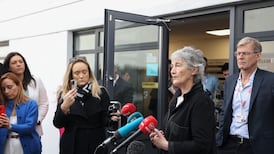Ireland’s first satellite, Educational Irish Research Satellite 1 (EIRSAT-1), is set to launch into space within the next fortnight.
Having left Ireland in the hand luggage compartment of an Aer Lingus flight in October, the satellite is now in Vandenberg Air Force Base in California, ready to piggyback into space attached to Elon Musk’s Space X Falcon 9 rocket at the end of November.
The EIRSAT-1 mission has been driven by a team of students and staff at University College Dublin (UCD) for the past six years.
“So many Irish people have gone before us, that have worked for ESA, Nasa, but not in the context of an Irish project. To be the first Irish space project, that’s really something special,” said Dr David Murphy, lead systems engineer for the mission.
READ MORE
Ireland’s first satellite, a model 2U CubeSat, was developed through a European Space Agency (ESA) “Fly your Satellite!” student programme, and was also supported by a number of Irish Government agencies.
All going well, EIRSAT-1 will ride 550km above Earth’s orbit before dispensing from the rocket, unfurling its five antennas, and “that’s when we’ll begin the science”, according to Dr Murphy.
EIRSAT-1 has been built to detect gamma ray bursts, which can be studied to help understand the physics of the early universe, as well as to test a novel control software designed by UCD’s dynamics and control group, and to test the durability of protective coating technology developed by Irish space company Enbio.
Dr Rachel Dunwoody, payload and operations specialist for the mission, who also completed her Masters and PhD on the EIRSAT-1 project, said that it is an amazing educational opportunity.
“We’ve been able to travel to these state-of-the-art ESA facilities and run test campaigns, we convened with ESA experts, it’s just been a really amazing learning opportunity,” she said.
Dr Murphy said that the growing number of Irish companies that are working in the space industry are “hoovering up” their graduates.
“Our students already have the skills to hit the ground running when they want to join industry, but with EIRSAT we’ve obviously just kicked it up another level altogether,” he said.
“The space industry in Ireland is just growing incredibly. You can see the difference from even when we started EIRSAT-1 to where the industry is now. It’s a massively growing sector across the world and various companies can get involved with that, and they can really reap the benefits,” said Dr Murphy.
As EIRSAT-1 goes into orbit this month, UCD already has a number of other space projects in the works, including building of a new satellite triple the size of EIRSAT-1 led by Professor Sheila McBreen, and a cross-European collaboration to build a Compton Telescope in a Cubesat led in UCD by Professor Lorraine Hanlon, with Dr Murphy leading a spin-out study on how a swarm of Cubesat satellites would work together.















